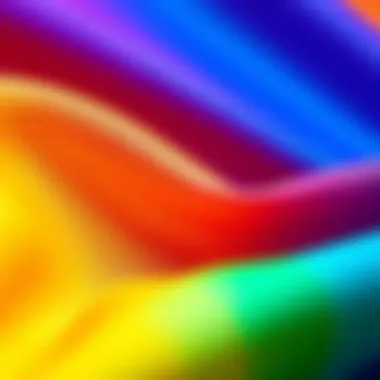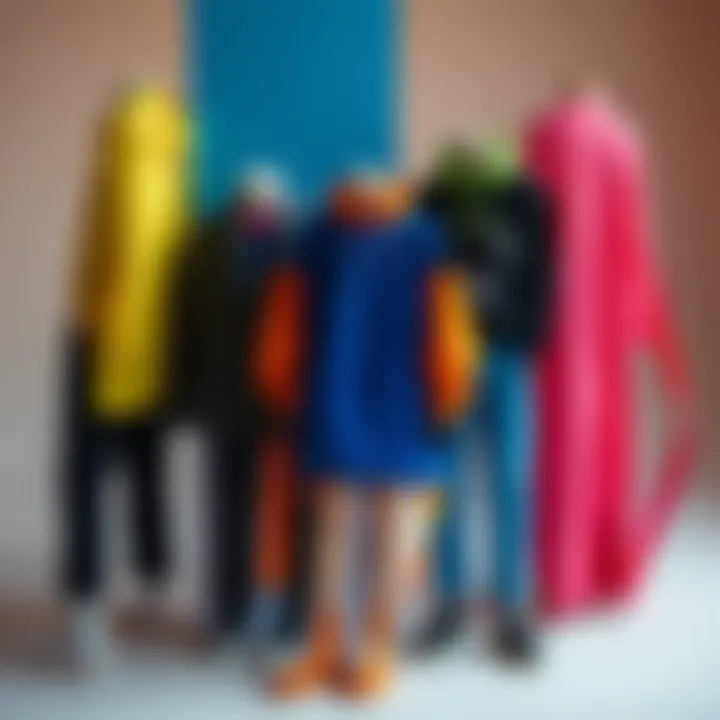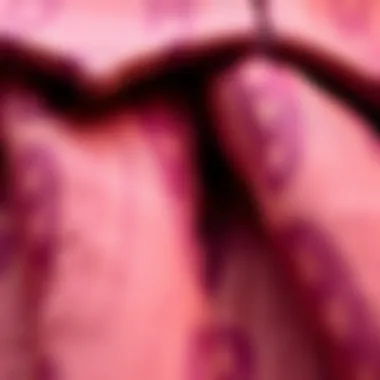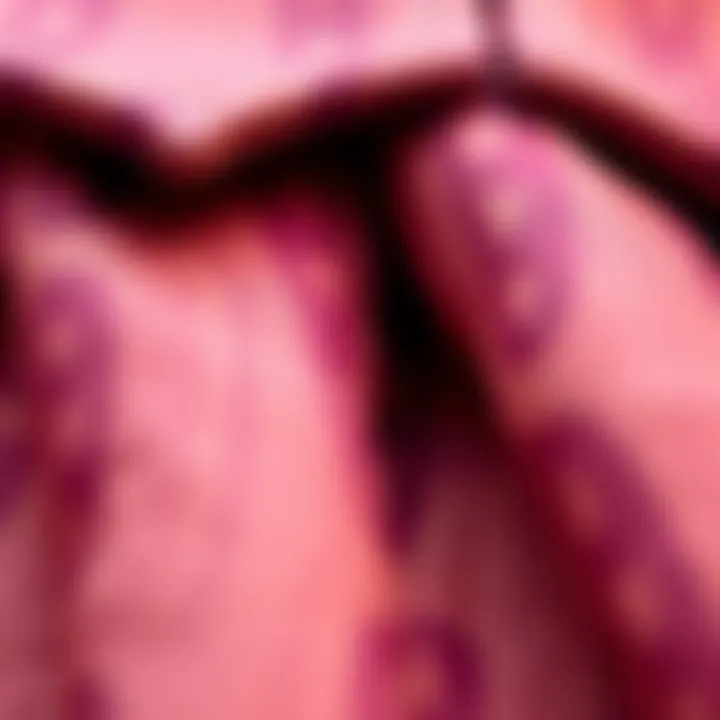The Impact of Vivid Clothing on Contemporary Fashion


Intro
Fashion is often seen as a reflection of culture, identity, and self-expression. A significant aspect of this expression comes from color and fabric choices. In today's dynamic fashion landscape, vivid clothing stands out, capturing attention and evoking emotions. Bright colors and innovative fabrics are not just trends; they symbolize a deeper understanding of personal style and sustainability.
This article takes a closer look at how vivid clothing influences contemporary fashion. Through exploring color theory, fabric selection, and their cultural implications, we aim to uncover what makes these bold choices significant. Furthermore, we will discuss the psychological effects colors have on individuals and how clothing becomes a mediums for expressing creativity. By analyzing evolving trends, this deep dive seeks to encourage fashion enthusiasts and industry professionals alike to appreciate and utilize the vibrant palette at their disposal.
The Importance of Color in Fashion
Color is not merely a visual experience; it plays a fundamental role in fashion and personal expression. The hues we choose to adorn ourselves with hold the power to influence mood, convey messages, and even shape our identities. Understanding color's significance is essential for anyone involved in the fashion industry, from designers and stylists to marketers and students. This section aims to shed light on the multifaceted nature of color in fashion, enhancing both the appreciation and intentional use of vivid clothing.
Understanding Color Theory
Primary Colors and Their Impact
At the core of color theory lie the primary colors: red, blue, and yellow. These shades serve as the foundation for all other colors, acting as the building blocks for exquisite palettes that captivate the eye and excite the imagination. Each primary color evokes distinct emotions. Red, for instance, is often associated with passion and energy, making it a popular choice in pieces designed to grab attention. The appeal here is rooted in its ability to virtually scream "look at me!". In this article, we will discuss how incorporating primary colors effectively can elevate any fashion ensemble.
Color Combinations That Work
Creating harmonious color combinations is where the true art of fashion comes alive. A well-combined color palette can create a sense of balance and intrigue, leading to a more striking overall appearance. Think complementary colors, where opposites attract. For instance, pairing a vibrant orange with deep blue can breathe life into any outfit. The challenge lies in finding the right mix. Utilizing color theory principles, such as analogous or triadic color schemes, opens up a treasure trove of possibilities. This section will help readers navigate the intricacies of color pairing for a cohesive look.
Psychological Effects of Color
The psychological effects of color are profound and can sway emotions and behaviors. For example, wearing black often implies sophistication and authority, while brighter hues tend to uplift spirits and encourage a sense of joy. Understanding these effects when selecting clothing is crucial. By tapping into the psychological aspects of color, one can make deliberate choices that resonate with their mood or the message they wish to convey. This article will explore the compelling relationship between color and psychology, arming readers with insights to make informed fashion decisions.
Cultural Significance of Color
Colors in Various Cultures
Colors possess different meanings across cultures, enriching the tapestry of global fashion. For example, in Western traditions, white is often associated with purity and new beginnings—think weddings. Conversely, in some Eastern cultures, it symbolizes mourning. Recognizing these cultural nuances can enhance cross-cultural fashion appreciation and design. This section will delve into how understanding these meanings can elevate or hinder clothing choices in diverse environments.
Symbolism in Clothing Choices
Clothing often tells a story, and color is a vital part of that narrative. The symbolism of color can vary widely, impacting how attire is perceived in different contexts. For example, the color green often represents growth and renewal, making it a popular choice in eco-friendly fashion. Understanding the symbolic nature of colors enables people to communicate effectively through their clothing. This article will explore various colors' meanings and implications, shedding light on how they shape personal and societal fashion narratives.
Traditional vs. Contemporary Uses
Fashion is a living entity, constantly evolving while being rooted in tradition. The historical significance of colors in traditional attire reflects cultural identity and values. However, contemporary fashion often seeks to challenge these norms, using color in innovative ways. This juxtaposition creates a dynamic conversation between history and modernity. The discussion in this section will center on how traditional and contemporary uses of color coalesce, influencing current fashion trends.
"Colors speak louder than words in the realm of fashion, telling stories that transcend language and geography."
As this exploration unfolds, the interplay of color and culture will illuminate the profound impact these elements have in driving fashion choices around the globe.
A Spectrum of Vivacity: Types of Vivid Clothing
Vivid clothing encompasses a dazzling array of patterns and solid colors, each carrying its own significance in the fashion world. Understanding these types is crucial not only for personal style but also for recognizing the broader cultural and psychological implications. Bright designs can captivate attention and influence emotional responses, proving that the choices we make in our wardrobe can reflect who we are. This section unpacks the diverse types of vivid clothing, providing insight into their defining characteristics and benefits.
Bright and Bold Patterns
Patterns in clothing often serve as a canvas for self-expression. Bright and bold designs can turn a simple outfit into a statement piece, making them incredibly relevant in contemporary fashion.
Geometric Patterns
Geometric patterns bring a fresh, architectural feel to fashion, often creating visual intrigue and excitement. These shapes can vary from circles and triangles to more complex tessellations.
Geometric designs are favored for their ability to evoke a structured, modern aesthetic while adding a playful touch to any wardrobe. They are particularly effective in professional attire, where a splash of creativity can make an outfit memorable.
However, it’s worth noting that geometric patterns can sometimes clash if not paired correctly. Solid colors often act as a great companion to such prints, balancing the overall look.
Floral Prints
Floral prints stand out with their vivid colors and often intricate designs, painting clothing with the essence of nature. They symbolize renewal and vibrancy, making them a popular choice, especially during spring and summer seasons. Using floral patterns can evoke a sense of femininity and softness in one's outfit, appealing to various communities in fashion. However, excessive layering of floral prints may overwhelm the outfit, leading to a disjointed look.
Animal Prints
Animal prints are a bold statement that captures raw and untamed energy. They are versatile and can be found across numerous clothing items, like shirts, shoes, and even accessories. The appeal of animal prints lies in their ability to convey a sense of adventure and confidence. These designs range from classic leopard spots to zebra stripes, each bringing its own unique flair to the table. Nevertheless, the challenge lies in styling these pieces carefully to avoid looking too costume-like. Pairing them with more subdued colors can create a striking yet balanced appearance.


Solid Vivid Colors
Solid colors are powerful in their simplicity, dominating in their ability to make a statement without the need for intricate designs. Their importance cannot be underestimated in the landscape of vivid clothing as they often serve as the backbone of any wardrobe.
The Power of Red
Red has long been associated with passion, power, and energy. Wearing this color can bring about a sense of confidence and authority, making it a top choice for those looking to command attention. One of its unique features is its versatility; it can fit into formal settings as easily as it can casual ones. However, it's essential to wear red thoughtfully, as its boldness can be overwhelming without careful styling.
Blue and Its Variants
The color blue evokes a sense of calm, reliability, and peace. With its many variants, from sky to navy, it offers a wide palette to choose from. Light blues are often seen as refreshing and unobtrusive, while darker shades carry a sense of sophistication. In various cultural contexts, blue often symbolizes trust and loyalty. One potential downside is that when not styled correctly, it can come off as monotonous, so it may be beneficial to pair it with contrasting colors to bring the outfit to life.
Greens and Their Refreshing Qualities
Green is synonymous with nature, renewal, and growth. Its various shades can invoke feelings of balance and tranquility, appealing to a broad range of fashion enthusiasts. Lime green can bring vibrancy and energy, while deep forest green suggests depth and richness. However, much like other colors, it can be tricky to pair; wearing multiple shades of green without contrast could lead to a blend that lacks emphasis. Adding neutral tones can enhance the outfit and create a more dynamic look.
Each type of vivid clothing plays an essential role in fashion, contributing to personal expression and societal cultural norms. Understanding the reasons behind these choices can help in making informed decisions about style.
Materials That Bring Vivid Clothing to Life
In the vibrant world of fashion, the choice of materials can make or break a piece of clothing’s visual impact. Different fabrics can enhance or dampen the liveliness of colors, thereby playing a pivotal role in how garments are perceived and worn. Understanding the properties of various materials—from natural fibers to synthetic options—provides insight not only into their aesthetic value but also into their functionality and sustainability. With the growing emphasis on vivid clothing, designers must consider both the allure and the ethics behind their fabric choices.
Natural Fabrics
Cotton's Vibrancy
Cotton has long been the backbone of fashion due to its inherent adaptability and breathability. When dyed in vibrant shades, cotton retains color remarkably well, resulting in a fabric that feels fresh and alive. Its ability to absorb dyes makes it a favorite among designers who seek rich colors in their creations.
One distinctive feature of cotton is its softness, which not only contributes to comfort but also enhances how colors manifest. This softness allows the material to drape beautifully over the body, further magnifying the visual appeal of vivid hues. However, its tendency to wrinkle and fade over time could be seen as a drawback in fast-fashion contexts. Overall, cotton serves as a striking choice for anyone wanting to incorporate bright tones into their wardrobe without compromising on comfort.
Silk and Its Luster
Silk, with its luxurious sheen and smooth texture, offers an elegance to vivid clothing that few other fabrics can match. This material is known for its distinctive ability to reflect light, which can transform even the simplest designs into something truly captivating. Bright colors come to life on silk, exhibiting a shine that draws attention. Furthermore, silk's lightweight nature allows it to flow gracefully, ensuring that every movement is fluid. On the downside, silk requires careful maintenance; it may stain easily and often needs dry cleaning. This necessity can deter some consumers. Nevertheless, for formal occasions or high-end fashion, silk remains a top-tier fabric choice that breathes life into vivid colors.
Wool and Texture
Wool, although traditionally recognized for its warmth and insulation, has unique benefits that enhance its appeal in the realm of vivid fashion. Wool fibers hold dye exceptionally well, leading to deep, saturated colors that maintain their brilliance over time. A distinctive characteristic of wool is its natural texture, which not only adds visual interest but also contributes to the tactile experience of wearing vivid garments. Additionally, wool's moisture-wicking ability makes it practical for various climates. However, it can be heavy and itchy for some wearers, which might limit its appeal in casual settings. But for those who appreciate the substance and durability that wool offers, it can be a marvelous addition to a wardrobe bursting with color.
Synthetic Fabrics
Polyester for Durability
Polyester is a synthetic powerhouse. Its ability to withstand wear and tear makes it a popular choice for clothing that projects both vividness and longevity. When dyed, polyester can achieve vibrant shades that are often more resilient to fading than natural fibers, making it perfect for fast-paced lifestyles. A key advantage of polyester is its quick-drying nature, a feature that carries substantial appeal for those in active environments or climates. Nevertheless, polyester isn’t without its flaws; breathability isn’t its strong suit, which can lead to discomfort in hot weather. But if durability and vivid color retention are the main goals, polyester is hard to beat.
Viscose and Its Fluidity
Viscose is sometimes seen as a less familiar choice in the world of vivid clothing, but its appeal is growing. Known for its silky feel and flowing drape, viscose is derived from natural materials, presenting a combination of beauty and sustainability. It takes dye beautifully, resulting in rich colors that seem to float on the fabric. This fluidity enhances the wearability of vivid designs, inviting movement and creating an eye-catching aesthetic.
That said, viscose can be prone to shrinking and requires careful handling in laundering. Even so, its aesthetic benefits often outweigh its disadvantages for fashion that prioritizes both color and comfort.
Nylon's Role in Active Wear
Nylon has made waves in the active fashion scene, renowned for its strength and elasticity. This fabric holds color exceptionally well, which plays a crucial role in vibrant sportswear. A defining feature of nylon is its lightweight nature, allowing for easy movement, which is particularly essential in activewear. Additionally, it resists mildew and mold, making it ideal for those engaging in outdoor activities. However, some consumers may favor natural fibers due to comfort concerns, as nylon can trap heat against the skin. Yet, for a durable, vibrant choice in sportswear, nylon undoubtedly shines in the world of vivid clothing.
Vivid Clothing in Personal Expression
Vivid clothing serves as more than just fabric draped over our bodies; it acts as a powerful vehicle for expressing who we are. In today’s world, clothing is our canvas, showcasing not only our likes and dislikes but also our personalities and beliefs. The bold hues and rich patterns invite a deeper narrative about the individual beneath them. This section examines how vivid garments contribute to personal expression, exploring the nuances of color palettes and their profound effects on identity.
Creating a Color Palette
Finding Your Personal Colors
Finding personal colors is like choosing a soundtrack for your life. It shapes how you feel and how you are perceived. Each person has a unique combination of hues that complement their skin tone, eyes, and hair color. This harmony creates a visual impact that resonates deeply with personal style. Selecting colors that align with one’s features can boost confidence and provide a sense of comfort in daily wear. It's been noted that individuals often feel more authentic and energized when adorned in their ideal color scheme.
However, diving into your personal palette requires some trial and error. While you might find certain shades flattering, others may not evoke the same response. Thus, the process can be both rewarding and frustrating. Just as an artist experiments with different shades, so too should you explore various color options until you find what truly resonates.
Mixing and Matching Shades
Mixing and matching shades is an art form in itself. Taking the time to fuse various colors allows individuals to display their creativity and independence. When done right, your closet can transform into a visual feast. The ability to contrast and complement hues enables you to create distinct outfits for any occasion, reflecting mood and circumstance with unparalleled ease. For instance, wearing a mustard-yellow top can evoke feelings of warmth, particularly when paired with a deep navy bottom.


On the flip side, mixing and matching can be quite tricky. Some color combinations may clash, leading to a disjointed appearance that detracts from the intended expression. It’s crucial to understand color theory fundamentals to navigate this complex interplay effectively. In learning how to harmonize shades, there's a chance of discovering a personal style that feels irresistibly authentic.
Color Harmony in Outfits
Color harmony takes mixing and matching to a more refined level. It involves combining colors in a strategic manner that promotes a sense of unity and coherence in outfits. Utilizing color wheels or traditional schemas—such as complementary and analogous colors—can significantly enhance the overall aesthetic. The main characteristic here lies in achieving balance; even the most vivid colors can coexist beautifully when harmonized correctly.
The appeal of color harmony is its visual pleasingness. Outfits that exhibit a sense of pop while remaining tasteful can leave lasting impressions. However, if one leans too heavily on harmony, there’s a risk of staleness. Sticking too close to established norms might stifle individuality, as it can create an appearance that lacks personal touch or uniqueness. Finding the balance between harmony and personal expression is crucial for those endeavoring to fully embrace the vivid clothes they wear.
Vivid Clothing in Identity
Expressing Mood Through Color
Clothing colors can speak volumes without uttering a single word. In the realm of self-expression, the ability to convey one's mood through vibrant palettes is both liberating and empowering. The choice of color can set the tone for an entire day. For instance, wearing bright orange might exude energy and enthusiasm, while opting for a cool blue could project calmness and serenity. Deliberating over color choices can actually help individuals navigate their emotions, making clothing an effective tool for emotional expression.
Yet, oversaturation of upbeat colors might not always translate into positive experiences. Not every vibrant hue influences mood in the same manner; personal associations with colors can vary widely by experience. This intricacy shows the importance of being attuned to how colors resonate personally.
Cultural Identity and Fashion
Clothing is a mirror reflecting the cultural backdrop from which it springs. Vivid clothing often carries cultural significance that goes beyond aesthetics. Various cultures integrate colors into their traditions, signifying different meanings and values. A bright red in some cultures stands for good fortune, while in others, it may connote anger or sacrifice. This manifestation allows for robust cultural narratives and personal identity through clothing,
However, cultural appropriation poses a dilemma—when someone dons clothing symbolic of another culture without understanding its significance, it may lead to misunderstandings or disrespect. A mindful approach to cultural influences in fashion diminishes these risks while still celebrating the diverse spectrum of colorful clothing.
Personal Branding with Color
In the world of social media and branding, the colors we wear become a form of personal marketing. Each shade chosen can become tightly linked to one's individual brand. For instance, tech entrepreneurs may favor sleek, monochromatic looks in minimalistic tones, while creatives might opt for bold, eye-catching patterns that reflect their dynamism. This deliberate alignment of color and personal branding simplifies how others perceive and remember individuals.
However, alignment also requires consistency. Constantly switching hues or styles might confuse audiences regarding what one represents. Therefore, effectively utilizing color for personal branding may necessitate fine-tuning and strategic planning, balancing authenticity and marketability.
Vivid clothing in personal expression encapsulates a wide net of emotional depth, cultural significance, and individual character. Each layer adds richness to the overall narrative that clothing weaves, highlighting its importance as a medium of communication and self-exploration.
Sustainable Practices in Colorful Fashion
Sustainable practices in fashion are no longer just a niche; they're becoming a necessity. As the demand for colorful and vibrant clothing increases, the fashion industry faces pressing questions regarding the environmental impact of its production processes. In this section, we will explore various sustainable trends and innovations, emphasizing the benefits they bring not only to the environment but also to the creative expression that vivid clothing embodies.
Eco-Friendly Dyes
Plant-Based Dyes
Plant-based dyes have emerged as a star player in sustainable fashion. These dyes originate from natural sources like plants, minerals, and insects. One key characteristic of plant-based dyes is their biodegradability. Unlike synthetic alternatives, these dyes return harmlessly to the earth. A plant-based dye such as indigo, often derived from the leaves of the indigo plant, showcases rich colors that can bring clothing to life while being environmentally conscious.
Advantages:
- Reduced Chemical Footprint: Less reliance on harmful substances makes these dyes safer for manufacturers and consumers alike.
- Unique Coloration: The hues are often softer and can have variations that are harder to achieve with synthetic dyes, giving garments an organic vibe.
However, there are some challenges. The colorfastness and consistency of these dyes can sometimes not match that of synthetic dyes, which may limit their application in high-demand fashion cycles.
Water-Saving Dye Technologies
Water-saving dye technologies are gaining ground as a pivotal innovation in the quest for sustainability. The textile industry is notorious for excessive water use, often estimated in thousands of liters for a single garment. This technology focuses on reducing water consumption significantly. For instance, methods like digital printing can drastically limit water usage while still enabling vibrant colors to shine through.
Advantages:
- Efficient Use of Resources: By prioritizing water conservation, the industry not only saves money but also minimizes its environmental impact.
- Color Retention: These technologies often lead to brighter colors retaining their vibrancy for longer periods, which is a win for both aesthetic and sustainable practices.
Nonetheless, the technology can come with a higher initial investment, which might deter smaller labels from adopting these methods right away.
Impact of Chemical Dyes on Fashion
The impact of chemical dyes on fashion can hardly be overstated. These dyes have dominated the market, but their benefits come with a heavy price—in most instances, substantial environmental harm. While they offer vibrant colors and excellent penetration into fabrics, the negative repercussions are significant. Heavy metal contaminants and toxic waste are often the byproducts of chemical dye processes.
Key Characteristic:
- Brightness and Cost-Effectiveness: Chemical dyes can produce eye-popping colors quickly and efficiently, making them attractive to manufacturers focused on cost.


However, detrimental ecological impacts such as water pollution and potential health risks must not be overlooked. With burgeoning awareness among consumers, brands are increasingly held accountable for their dye choices, pushing the industry towards a more sustainable future.
Innovations in Sustainable Fabrics
Recycled Materials
Recycled materials are carving a niche in vibrant fashion by turning waste into stylish clothing. This approach helps minimize landfill contributions and reduces the need for virgin materials, effectively lowering the carbon footprint of the fashion industry. Various brands are experimenting with integrating recycled polyester from plastic bottles, creating not only eye-catching garments but also a message of sustainability.
Advantages:
- Circular Economy: Utilizing recycled materials fosters a circular economy, encouraging consumers to rethink their relationship with clothing.
- Resource Efficiency: Reduces the demand for raw material extraction, conserving energy and resources.
However, there remains a balance to strike; manufacturing conditions and the quality of recycling processes can impact the final product.
Bamboo Fabric Innovation
Bamboo fabric innovation represents an exciting fusion of sustainability and comfort. Bamboo is naturally fast-growing and requires less water, making it an environmentally friendly option. Its soft texture and natural antibacterial properties are compelling for garment construction.
Advantages:
- Natural Breathability: The moisture-wicking properties make bamboo fabric suitable for a variety of clothing types, particularly during warm weather.
- Low Chemical Use: Bamboo's growth requires fewer pesticides, fostering a healthier ecosystem.
Nonetheless, it’s essential to note that while the bamboo industry holds a lot of promise, the processes used to turn raw bamboo into fabric can sometimes involve chemicals that counteract its sustainability claims.
Organic Cotton Growth
Organic cotton growth is on the rise, as consumers become more conscious of their clothing choices. Organic cotton is grown without synthetic fertilizers or pesticides, making it an important step towards eco-friendliness in textiles. This growth trend is fueled by a shift in consumer sentiment, where the demand for not just vibrant colors, but vibrant practices, is on the forefront.
Advantages:
- Healthier Soil and Ecosystem: Building healthier ecosystems positively impacts local biodiversity.
- Consumer Trust: As consumers look for responsibly sourced clothing, organic cotton provides them with assurance of quality and care.
However, organic cotton often comes with a higher price tag, which can deter some consumers, and also yields less product compared to conventional cotton.
The journey to sustainable fashion isn't just about materials—it's about the choices we make and the impact of those choices on our world.
The Future of Vivid Clothing
The landscape of fashion is an ever-morphing canvas, and vivid clothing stands at the forefront of this evolution. As we venture into the future, the aformentioned creations not only symbolize personal expression but also embrace technology, sustainability, and cultural exchange. Understanding these elements fosters a deeper appreciation and readiness for what lies ahead in the colorful world of fashion.
Emerging Trends
Streetwear Influences
Streetwear, with roots in urban culture and youth movements, has planted itself firmly in the realm of vivid clothing. It’s more than just a style; it’s a cultural statement that often juxtaposes high fashion with everyday life. The key characteristic of streetwear is its accessibility, making bold patterns and colors available to the masses. This democratization of fashion means that anyone can flaunt their personality through vivid attire.
An example of this would be hoodies and sneakers adorned with striking graphics or neon hues. Such choices bring a fresh wave of expression that resonates with a younger audience, creating a community around vibrant styles. The downside, however, lies in the oversaturation of trends. In a crowded market, what once felt unique risks becoming just another face in the crowd.
Tech-Integrated Fashion
As we step into an era dominated by ingenuity, tech-integrated fashion is swiftly gaining traction. This encompasses everything from wearable technology to smart fabrics that respond to environmental stimuli, which can enhance the vividness of clothing through color change or texture adaptation. The key characteristic of this trend rests in how it amplifies personal expression not just visually, but also functionally. Integration of tech allows clothing to serve multiple purposes, merging style with utility. Yet, there are challenges; the high cost of production and maintenance may alienate consumers who wish to embrace such innovations. The complexities of blending fashion with technology also raise concerns about sustainability and waste, necessitating careful consideration by designers and marketers alike.
Global Cultural Fusion
Globalization has ushered in an exciting era of cultural fusion, where clothing can reflect a tapestry of influences from around the world. This melding of styles encourages brightness and variety, appealing to those who seek unique forms of expression. At its core, global cultural fusion democratizes vivid clothing, allowing individuals to mix patterns from Eastern designs with Western silhouettes, producing something entirely new and eye-catching. This blending is beneficial, as it promotes understanding and celebrates diversity through fashion. However, there is a fine line between appreciation and appropriation. Designers must tread carefully to respect origins and acknowledge cultural contexts. Failing to do so threatens to undermine the very essence of the vibrant clothing they aim to represent.
The Role of Technology in Vibrancy
Technology and fashion are intertwined more now than ever, playing a pivotal role in elevating vivid clothing from mere fabric to a statement.
Color Prediction Algorithms
Color prediction algorithms are transforming how designers select palettes for upcoming collections. These algorithms analyze trends across social media, fashion weeks, and consumer behavior to predict which colors will captivate audiences next season. The ability to harness big data in this manner allows for more impactful marketing strategies. It’s a game for brands striving to remain relevant in a fast-moving marketplace. However, the reliance on algorithms can lead to a homogenization of color choices across the industry, as brands chase the same insights without adding their unique twist. This raises questions about creativity versus competition in a shared space.
Augmented Reality in Measurement
Augmented reality (AR) is paving new paths in how we perceive and fit clothing. Retailers are now experimenting with AR to allow customers to visualize how vivid clothing looks on them without physically trying it on. This technology borders on revolutionary, cutting the hassle of returns and improving customer satisfaction. Yet, there lies a challenge in ensuring AR technology is reliable. If the virtual match falls short in the real world, it can lead to disappointed buyers and tarnished brand reputations.
3D Printing and Material Innovations
3D printing is at the cutting edge of fashion, offering possibilities to create and customize vivid clothing unlike ever before. This technology allows designers to experiment with unusual textures and vibrant color combinations in a cost-effective way. The beauty of this innovation is that it shortens the supply chain and can utilize sustainable materials to address environmental concerns.
However, 3D printing still faces logistical hurdles regarding scalability and production speed, which can inhibit wider adoption in the fast-paced world of fashion.
Cautious yet courageous, the industry must balance vibrant aesthetics with ethical considerations and sustainability.















